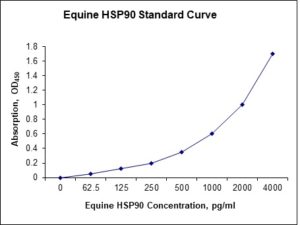Nori Equine HSP90 ELISA Kit
$461.00 – $832.00
This ELISA kit is for quantification of HSP90 in horse. This is a quick ELISA assay that reduces time to 50% compared to the conventional method, and the entire assay only takes 3 hours. This assay employs the quantitative sandwich enzyme immunoassay technique and uses biotin-streptavidin chemistry to improve the performance of the assays. An antibody specific for HSP90 has been pre-coated onto a microplate. Standards and samples are pipetted into the wells and any HSP90 present is bound by the immobilized antibody. After washing away any unbound substances, a detection antibody specific for HSP90 is added to the wells. Following wash to remove any unbound antibody reagent, a detection reagent is added. After intensive wash a substrate solution is added to the wells and color develops in proportion to the amount of HSP90 bound in the initial step. The color development is stopped, and the intensity of the color is measured.
Alternative names for HSP90: Heat shock protein 90
This product is for laboratory research use only not for diagnostic and therapeutic purposes or any other purposes.
- Description
- How Elisa Works
- Product Citation (0)
- Reviews (0)
Description
Nori Equine HSP90 ELISA Kit Summary
Alternative names for HSP90: Heat shock protein 90
Alternative name for equine: Horse
| Assay Type | Solid Phase Sandwich ELISA |
| Format | 96-well Microplate or 96-Well Strip Microplate |
| Method of Detection | Colorimetric |
| Number of Targets Detected | 1 |
| Target Antigen Accession Number | Q9GKX7 |
| Assay Length | 3 hours |
| Quantitative/Semiquantitative | Quantitative |
| Sample Type | Plasma, Serum, Cell Culture, Urine, Cell/Tissue Lysates, Synovial Fluid, BAL, |
| Recommended Sample Dilution (Plasma/Serum) | No dilution for sample <ULOQ; sufficient dilution for samples >ULOQ |
| Sensitivity | 12 pg/mL |
| Detection Range | 62.5-4000 pg/mL |
| Specificity | Equine HSP90 |
| Cross-Reactivity | < 0.5% cross-reactivity observed with available related molecules, < 50% cross-species reactivity observed with species tested. |
| Interference | No significant interference observed with available related molecules |
| Storage/Stability | 4 ºC for up to 6 months |
| Usage | For Laboratory Research Use Only. Not for diagnostic or therapeutic use. |
| Additional Notes | The kit allows for use in multiple experiments. |
Standard Curve
Kit Components
1. Pre-coated 96-well Microplate
2. Biotinylated Detection Antibody
3. Streptavidin-HRP Conjugate
4. Lyophilized Standards
5. TMB One-Step Substrate
6. Stop Solution
7. 20 x PBS
8. Assay Buffer
Other Materials Required but not Provided:
1. Microplate Reader capable of measuring absorption at 450 nm
2. Log-log graph paper or computer and software for ELISA data analysis
3. Precision pipettes (1-1000 µl)
4. Multi-channel pipettes (300 µl)
5. Distilled or deionized water
Protocol Outline
1. Prepare all reagents, samples and standards as instructed in the datasheet.
2. Add 100 µl of Standard or samples to each well and incubate 1 h at RT.
3. Add 100 µl of Working Detection Antibody to each well and incubate 1 h at RT.
4. Add 100 µl of Working Streptavidin-HRP to each well and incubate 20 min at RT.
5. Add 100 µl of Substrate to each well and incubate 5-30 min at RT.
6. Add 50 µl of Stop Solution to each well and read at 450 nm immediately.
Background:
Heat shock protein 90 (Hsp90) is a chaperone protein that assists other proteins to fold properly, stabilizes proteins against heat stress, and aids in protein degradation. It also stabilizes a number of proteins required for tumor growth, which is why Hsp90 inhibitors are investigated as anti-cancer drugs. Heat shock proteins, as a class, are among the most highly expressed cellular proteins across all species.[1] As their name implies, heat shock proteins protect cells when stressed by elevated temperatures. They account for 1–2% of total protein in unstressed cells. However, when cells are heated, the fraction of heat shock proteins increases to 4–6% of cellular proteins.[2] This protein was first isolated by extracting proteins from cells stressed by heating, dehydrating or by other means, all of which caused the cell’s proteins to begin to denature.[3] However it was later discovered that Hsp90 also has essential functions in unstressed cells. The Hsp90 protein contains three functional domains, the ATP-binding, protein-binding, and dimerizing domain, each of which playing a crucial role in the function of the protein. The glucocorticoid receptor (GR) is the most thoroughly studied example of a steroid receptor whose function is crucially dependent on interactions with Hsp90.[51][52] Hsp90 stabilizes various growth factor receptors[59] and some signaling molecules including PI3K and AKT proteins. Hence inhibition of Hsp90 may induce apoptosis through inhibition of the PI3K/AKT signaling pathway and growth factor signaling generally.[4] One important role of Hsp90 in cancer is the stabilization of mutant proteins such as v-Src, the fusion oncogene Bcr/Abl, and mutant forms of p53 that appear during cell transformation. It appears that Hsp90 can act as a “protector” of less stable proteins produced by DNA mutations.[5] Hsp90 is also required for induction of vascular endothelial growth factor and nitric oxide synthase.[25]
References
- Csermely P, et al. (1998). Ther. 79 (2): 129–68.
- Crevel G, et al. (2001). Cell. Sci. 114 (Pt 11): 2015–25.
- Prodromou C, et al. (2000). EMBO J. 19 (16): 4383–92.
- Grad I, Picard D (2007). Cell. Endocrinol. 275 (1–2): 2–12.
- Calderwood SK, et (2006). Trends Biochem. Sci. 31 (3): 164–72.
- Fontana J, et al. (2002). Res. 90 (8): 866–73.
Be the first to review “Nori Equine HSP90 ELISA Kit”
You must be logged in to post a review.





























Reviews
There are no reviews yet.